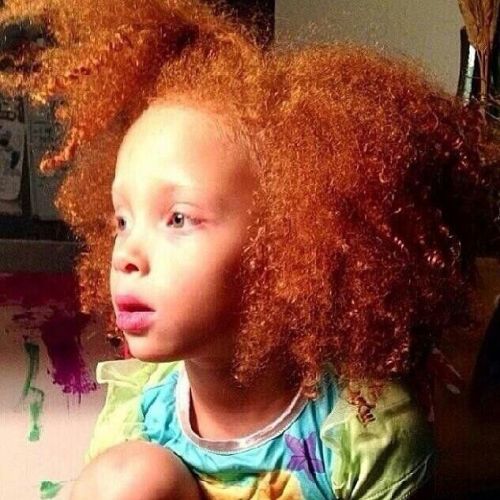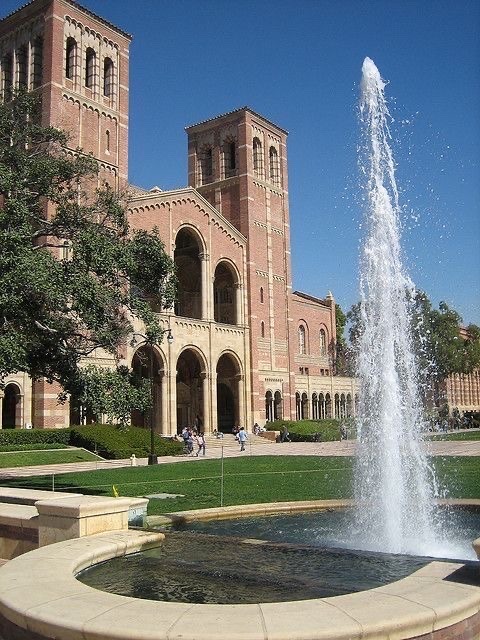🕊️
🕊️

More Posts from Arisaria and Others


Brandy

Sade <3









~array of Aaliyah albums, singles, and eps~




Aaliyah 🕊💕💗🎀🌼🌸🌺🪷🌷🌹💐








A redhead African is about as common as a European with red eyes. And there’s a good reason for this – being an albino causes them both.
Except when people are of mixed ancestry, red hair in Africans is usually caused by a kind of albinism. When people think of albinos, they tend to think of white hair, pale skin and red eyes. While this is true for Caucasians, albinism works differently in people of African descent.
There are a few different kinds of albinism in people of African descent, but the one that gives red hair is called rufous albinism. People with this condition have a red-bronze skin color, ginger-red hair, and blue or brown eyes.
How is someone an albino? All of our coloring – our skin, hair, and eye colors – comes from melanin. Melanin is just a pigment, or colored chemical substance, like the ones that are used to dye your clothes or maybe even your hair! Melanin comes in two different forms – pheomelanin (the red kind) and eumelanin (the brown kind).
It is significant that in ancient Egypt, as Manetho tells us, human sacrifices were offered at the grave of Osiris, and the victims were red-haired men who were burned, their ashes being scattered far and wide by winnowing-fans. It is held by some authorities that this was done to fertilize the fields and produce a bounteous harvest, red-hair symbolizing the golden wealth of the corn. But these men were called Typhonians, and were representatives not of Osiris but of his evil rival Typhon, whose hair was red Set was the black boar who swallowed the moon each month, obscuring its light. He was also identified with the hippopotamus, crocodiles, scorpions, turtles, pigs and donkeys - all animals which were considered to be unclean or dangerous. Some fish were considered to be sacred to Set (most notably the Nile carp and the Oxyrynchus) as they had apparently eaten the penis of Osiris after Set had dismembered the dead king. However, he was most often depicted as a “Set animal” or a man with the head of a “Set animal”. The Set animal (sometimes known as a"Typhonian animal" because of the Greek identification with Typhon) is a dog or jackal like creature, but it is not clear whether it exactly represented an extinct species, or was a mythological beast uniquely associated with Set himself.
.
He was thought to have white skin and red hair, and people with red hair were thought to be his followers. He was associated with the desert (which takes its name from the Egyptian word “dshrt” - the red place). He represented the fierce dry heat of the sun as it parched the land, and was infertile like the desert. Initially he probably represented the desert near Nubt, but soon he represented all deserts and foreign lands, becoming a god of overseas trade. Set had been associated with the desert and foreigners for some time before the Hyksos took over parts of lower Egypt. However, when they took him as their main god, this broke Set’s association withLower Egypt. His name was erased from monuments and his statues destroyed. All of his negative attributes were emphasised and his positive side was ignored.
The thing is that these days, having red hair and light skin can’t really hurt you because we spend a lot less of our time outside than our ancient ancestors did, and we have modern day conveniences like sunscreen. But 100,000 years ago when the first humans were evolving, things were a lot different.
Our ancestors most likely first developed in Africa where the sunlight is really strong, so they needed the protection that comes from darker skin. Red hair and light skin would have been very unhealthy, so it was selected against. As people moved farther north, the sun’s rays were less intense and they could afford to have mutations in their melanin system that gave them lighter skin and hair. That’s probably how we got the Caucasian red heads we have today who so often trace their roots to Northern Europe.
Groups who stayed in Africa would have still had some people with melanin mutations who survived and passed this trait on to future generations. That’s how there are modern day Africans with red hair. It just turns out that the most common mutation that stayed in the African population is different than the one that traveled north, and that’s why the African redheads are different from the Caucasian redheads.
https://www.youtube.com/watch?v=Hu0z6zyc2J8
#afrakan
#redhair
#afrakanredhair




"I love when you stare at me, I'm just so fresh, so clean" So Fresh, So Clean - Outkast
—————————————/—————————————
sources: @dreamymoonlight444, @tannedfiji, @jazzdharris on pinterest

"𝖨 𝗅𝗈𝗈𝗄𝖾𝖽 𝗈𝗏𝖾𝗋 𝗍𝗈 𝗍𝗁𝖾 𝗅𝖾𝖿𝗍 𝖬𝗆𝗆, 𝖨 𝗐𝖺𝗌 𝗅𝗈𝗈𝗄𝗂𝗇' 𝗌𝗈 𝗀𝗈𝗈𝖽 𝖨 𝖼𝗈𝗎𝗅𝖽𝗇'𝗍 𝗋𝖾𝗃𝖾𝖼𝗍 𝗆𝗒𝗌𝖾𝗅𝖿" Oops (Oh My) - Tweet |source: @luvmylee on pinterest|
~Spiritual Implications As Shown By Television~
---------------------------------ʚїɞ--------------------------------
This is sort of random thoughts but I thought this to be interesting so I'm sharing. As many may know by now, television and various shows and movies we view tell us certain spiritual truths yet their hidden in plain sight.
I could be wrong about this but for a while, I've been a fan of an anime called Seven Deadly Sins or Nanatsu No Taizai. One of the main reasons I enjoy it so much is because of the influences the author/writer, Nakaba Suzuki used in the making of it.
Various symbolisms within the show and the manga are very intriguing to me and I believe I happened to find one that could correlate to shadow work. If you don't know what that is, it's not a "New Age" practice but rather taking some time to be still, quiet, and think on the darker aspect of ourselves, the shadow, the part we suppress. Hence, "shadow work."
Anyway, there was a moment in the second season of the anime in which a central character, Meliodas, had to undergo certain training so he could receive the dark power he once had again.
If you're familiar with the franchise then you know that Meliodas is the leader of a group of powerful "warriors" or idk what to call them that each has one of the seven deadly sins (wrath, lust, greed, gluttony, slothfulness, pride, envy) assigned to them.
Meliodas is the sin of wrath and he was assigned this sin essentially because- well it's a long story, but, he completely decimated a kingdom with a great sum of his dark power that was taken from him as well as his wrath because he witnessed his reincarnated lover die once more in front of him (if you know, you know).
Nevertheless, once a new menace, the Ten Commandments appeared, he needed that power back. Yet, to make sure he would not go berserk again, he had to undergo training to control and face his emotions/wrath (that could stem from trauma).



Anyway, upon being taken through the trial, in which he had to revisit memories and strong negative emotions that could cause him to beserk, he eventually came to the point where he truly confronted the pain and in a way accepted it.



Not necessarily saying he (Meliodas) healed from anything but stepping away from the anime and into reality, we all have to face experiences in our lives that have caused us hurt, trauma, loss, and all kinds of negative emotions and things within ourselves in order to truly grow and flourish into the fullness of what you as a human and soul on this planet are supposed to become and learn/gain while here. (Also, notice how the place in which he was tested in is completely dark, possibly related to the whole shadow concept).
Not to mention, the place Meliodas and his crew at that point in the story visited was a place called "Istar." In the anime, it was the holy land of the druids but what I found interesting was how "Istar" is strikingly similar to "Ishtar" who is or was quite a significant goddess in various cultures around the world.
There is an ancient Sumerian story or legend called "The Descent of Ishtar" or Inanna in which the goddess descends into the seven gates of the underworld and by the time she reaches her sister who was the queen of the underworld, she is stripped naked and pretty much has lost her sense of self. Yet after having faced some adversity, she “resurrected” or rose out of the underworld a superior version of herself.
This analogy I believe is symbolic of coming into this world and the experiences we endure for our own separate personal purposes related to our own growth (which involves shadow work) but I don't know if that was on purpose by Nakaba or just me.
Lastly, once Meliodas is finished, he goes to receive his power from Zaneri’s (the one that gave Meliodas the test) older twin sister, Jenna. The name Jenna could be various things such as “white shadow/phantom,” “paradise,” “heaven,” “fair,” and so on. Which seems to be the opposite of what Meliodas just had to tackle within himself. 🤔
I apologize if this may seem random or if I’m reaching but it’s not written in stone, just random thoughts. Thanks for reading✨
---------------------------------ʚїɞ--------------------------------
Campus Hottie📓💒










-
 xdeadpetals liked this · 2 weeks ago
xdeadpetals liked this · 2 weeks ago -
 babiish liked this · 1 month ago
babiish liked this · 1 month ago -
 mashal90 reblogged this · 1 month ago
mashal90 reblogged this · 1 month ago -
 madeiinheavenn liked this · 1 month ago
madeiinheavenn liked this · 1 month ago -
 madeiinheavenn reblogged this · 1 month ago
madeiinheavenn reblogged this · 1 month ago -
 ayazubaydi liked this · 1 month ago
ayazubaydi liked this · 1 month ago -
 thoughtful-eso reblogged this · 1 month ago
thoughtful-eso reblogged this · 1 month ago -
 kindandprecious reblogged this · 1 month ago
kindandprecious reblogged this · 1 month ago -
 kindandprecious liked this · 1 month ago
kindandprecious liked this · 1 month ago -
 krissymoll reblogged this · 1 month ago
krissymoll reblogged this · 1 month ago -
 islam---posts reblogged this · 1 month ago
islam---posts reblogged this · 1 month ago -
 been-here-since-76 liked this · 2 months ago
been-here-since-76 liked this · 2 months ago -
 virgobtterfly reblogged this · 2 months ago
virgobtterfly reblogged this · 2 months ago -
 virgobtterfly liked this · 2 months ago
virgobtterfly liked this · 2 months ago -
 jayjay-barnes reblogged this · 2 months ago
jayjay-barnes reblogged this · 2 months ago -
 starryrika liked this · 3 months ago
starryrika liked this · 3 months ago -
 razzutarose234-blog liked this · 3 months ago
razzutarose234-blog liked this · 3 months ago -
 baharumutlari reblogged this · 3 months ago
baharumutlari reblogged this · 3 months ago -
 susanstar reblogged this · 3 months ago
susanstar reblogged this · 3 months ago -
 all-things-dreamy liked this · 3 months ago
all-things-dreamy liked this · 3 months ago -
 avealukich liked this · 3 months ago
avealukich liked this · 3 months ago -
 destinymarie liked this · 3 months ago
destinymarie liked this · 3 months ago -
 ancientcalls reblogged this · 4 months ago
ancientcalls reblogged this · 4 months ago -
 realmoos liked this · 4 months ago
realmoos liked this · 4 months ago -
 thelaady reblogged this · 4 months ago
thelaady reblogged this · 4 months ago -
 wassperrr liked this · 4 months ago
wassperrr liked this · 4 months ago -
 fahad077 liked this · 4 months ago
fahad077 liked this · 4 months ago -
 nfrtjytj reblogged this · 4 months ago
nfrtjytj reblogged this · 4 months ago -
 nfrtjytj liked this · 4 months ago
nfrtjytj liked this · 4 months ago -
 gold-empire reblogged this · 4 months ago
gold-empire reblogged this · 4 months ago -
 gold-empire liked this · 4 months ago
gold-empire liked this · 4 months ago -
 hagakuremarco liked this · 4 months ago
hagakuremarco liked this · 4 months ago -
 xlivingthecnalife reblogged this · 4 months ago
xlivingthecnalife reblogged this · 4 months ago -
 xlivingthecnalife liked this · 4 months ago
xlivingthecnalife liked this · 4 months ago -
 incoherence-mk3 reblogged this · 4 months ago
incoherence-mk3 reblogged this · 4 months ago -
 crossdresserica liked this · 4 months ago
crossdresserica liked this · 4 months ago -
 fvwela liked this · 4 months ago
fvwela liked this · 4 months ago -
 paul-island liked this · 4 months ago
paul-island liked this · 4 months ago -
 perfectlyimperfecttt reblogged this · 4 months ago
perfectlyimperfecttt reblogged this · 4 months ago -
 donswaves reblogged this · 4 months ago
donswaves reblogged this · 4 months ago
